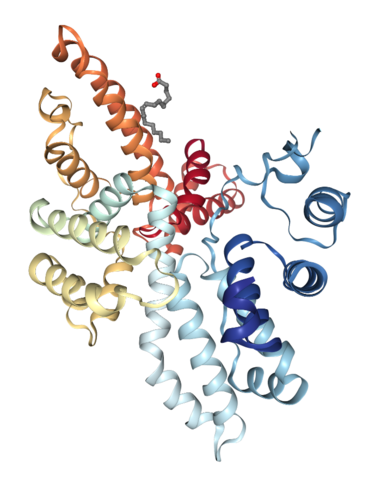Summary
Vitamin D binding protein (VDBP) serves several important functions in the body and is probably best known for its role in the transport of vitamin D metabolites. Given the widespread distribution of VDBP in the body and the complex nature of vitamin D metabolism, there has been renewed interest in understanding the relationship between VDBP concentrations and various health outcomes. NIST has developed a mass spectrometry-based method to measure VDBP in serum and plasma and assigned values for VDBP concentration in two NIST reference materials.
Description

Human Vitamin D Binding Protein in complex with 25-hydroxyvitamin D3
Vitamin D is essential for bone health, and vitamin D deficiency can lead to rickets in children and osteomalacia (soft bones) in adults. Vitamin D status is typically monitored through measurement of the metabolite 25-hydroxyvitamin D [25(OH)D] in serum. Most 25(OH)D is tightly bound to its transporter protein, vitamin D binding protein (VDBP) in circulation, with only a small fraction remaining unbound or bound to albumin. As a result, the first step in most measurement procedures for 25(OH)D is displacement from VDBP. Incomplete recovery of 25(OH)D could lead to erroneously low concentrations and an incorrect diagnosis of vitamin D deficiency. Some studies have also suggested that that the small fraction of unbound (“free” or “bioavailable”) vitamin D metabolites could be a better indicator of vitamin D status. Calculating the fraction of unbound 25(OH)D requires an assessment of VDBP concentration. Accurate measurements of VDBP are needed to promote understanding of the relationship between VDBP and 25(OH)D concentrations and to elucidate the role of VDBP in health and disease. NIST has partnered with the NIH Office of Dietary Supplements, the Vitamin D Standardization Program (VDSP), and the University of Washington to develop a mass spectrometry-based method for VDBP quantification.
Major Accomplishments
- A liquid chromatography – tandem mass spectrometry (LC-MS/MS) method was developed to quantify VDBP in serum and plasma
- VDBP was quantified in SRM 1949 Frozen Human Prenatal Serum (4 levels) and SRM 1950 Metabolites in Frozen Human Plasma

